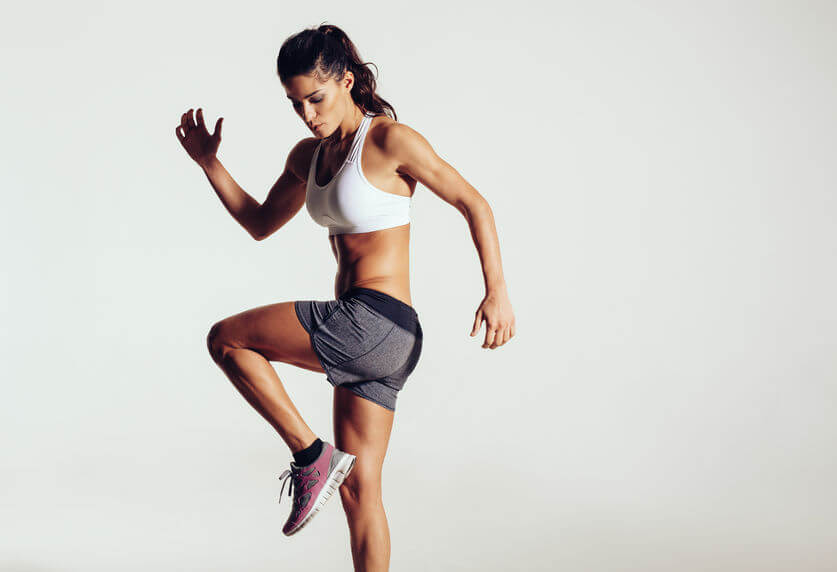LISS Training: Should You Try It? Everything you need to know!
Wondering what LISS training is and if you should try it?
I was racking my brains wondering the same thing.
So, I gathered and organized what I found across the web into this article. Everything you need to know about LISS is right here in one place.
In this article, I’ll cover what LISS training is, the benefits of LISS, how to do it, LISS cardio workouts, and more.
Contents
- What is LISS Training?
- The Benefits of LISS
- Does LISS Have Disadvantages?
- What is LISS Cardio?
- LISS FAQ
- Is LISS Good for Fat Loss?
- Is LISS or HIIT better for Fat Loss?
- How Long should You do LISS?
- What is Considered a LISS Workout?
- What should I Eat After LISS Cardio?
- What should I Eat Before LISS Cardio?
- What should My LISS Heart Rate be?
- How Many Times a Week should I Perform LISS Training?
- Is Yoga LISS?
- What are Examples of LISS?
- In Summary…
What is LISS Training?
LISS training stands for low-intensity steady-state training.
Okay, but what does that mean?
Essentially, LISS training involves performing an aerobic activity (or cardio) at a continuous, steady, and low-intensity pace over a set duration. When performing LISS, you ideally want to keep your heart rate at 50-65% of your maximum heart rate.
And while the term hasn’t been around for that long, this type of exercise regime has been used by fitness experts for more than a few decades.
Many fitness gurus balance out their high-intensity workouts with LISS training. Yet, this type of exercise routine only recently gained popularity within the masses.
What’s the Difference Between LISS and HIIT?
HIIT stands for high-intensity interval training. It’s more or less the opposite of LISS.
What’s the deal with HIIT?
HIIT involves high-intensity bursts of exercise, followed by a set period of rest. During HIIT, you give it your all. Frequently, you’ll aim for 80-95% of your maximum heart rate.
It also has sub-categories, like the Tabata protocol and some variations of CrossFit.
But that’s not all…
HIIT cardio is thought to have an ‘after-burn effect.’ This means that you burn fat, even when you are no longer exercising. And this is often why people love HIIT. It’s quick and it gets the job done.
So, what’s the difference? Why chose LISS?
The truth…
Both of these styles of training have their advantages and their disadvantages. In fact, combining HIIT and LISS can provide adequate recovery time and also improve your results.
When it comes to LISS training, this style is more of a brisk walk or light run. You do this over 30-60 minutes at a time. Further, LISS has benefits even for those that don’t perform HIIT, which I’ll explain in more detail in the next section below.
The Benefits of LISS
So, what are the advantages of LISS training? Why do people do it?
1. LISS is Relatively Safe
Whether you’re just starting out or you have a certain health condition, LISS is safe for most individuals. It doesn’t get your heart rate up to any dangerous levels (which could be detrimental to those with certain health or heart conditions).
And that’s not all…
It’s also safe in that it doesn’t place increased stress or compression on the joints.
HIIT frequently involves jumping or high-impact activities. But not LISS. It’s great for those with arthritis or for those bouncing back after an injury. In other words, it helps build healthy joints and tissues.
2. LISS is Great for Any Fitness Level
LISS training can help you slowly build up your endurance – without a high risk of injury.
Yet, it’s not just for beginners!
It’s a great form of recovery for individuals that perform HIIT sessions or other high-intensity exercises. It allows your body to move. It gets your blood flowing. In turn, this promotes better and faster recovery.
It further prevents overtraining. For instance, if you still want to move but you’re sore from your previous workout the day before, LISS is a great option to move.
3. LISS is Free
You don’t need any extra equipment to perform it. All you really need is a good pair of workout shoes and the great outdoors.
Head outside and take a brisk walk for 30-60 minutes – that’s LISS!
4. LISS Burns Fat
Wait a second… Doesn’t HIIT do this as well?
Yes, HIIT does this to an extent (more so after-the-fact).
But…
LISS leaves more oxygen available within your body.
What does this mean? When you have more oxygen, your body’s better equipped to burn fat. Fat needs oxygen to breakdown.
Whereas HIIT burns calories fast, LISS promotes proper metabolization of fat. And if your goal is to lose body fat, LISS is something you’ll want to include in your regular exercise routine.
5. LISS is Excellent for Endurance Training
Preparing for that next big marathon? Or perhaps a triathlon? You’ll want to get some LISS training into your schedule.
LISS places low stress on the heart and lungs over a long duration. In turn, this can prepare your body for long-distance or endurance-style events.
Does LISS Have Disadvantages?
Like anything, LISS comes with its fair-share of downsides. What should you be aware of?
1. LISS can be Boring (for Some)
Many individuals forego LISS because they don’t find it interesting enough.
And when it comes to exercise, you’ll want to find something that peaks your interest. This will keep you coming back for more. It helps you create a regular routine and habit.
However, there are ways to make LISS more interesting. Many people walk on a treadmill and read or watch TV. Others walk outside while listening to music or a podcast. This makes the time fly, without you getting bored.
You may even want to save a particular audiobook or podcast for when you perform your LISS sessions. This can provide motivation and make you look forward to it.
2. LISS Requires Time
Unlike HIIT, where you can complete a session within 15-20 minutes, LISS training occurs over a 30-60 minute timespan.
Many individuals just don’t have that kind of time. And that’s okay! LISS isn’t for everyone.
Although…
You could use it as your downtime! As aforementioned, set up a treadmill in front of the TV or talk a walk and listen to a podcast or book.
3. Overtraining Using LISS Increases Your Chance of Injury
If you cycle each day for 60 minutes, you’ll increase your chance of injuries.
How?
You’ll likely overwork the muscles. It leaves little time for those same muscles to repair and rest.
Ideally, you would do LISS 2-4 times a week alone, or you would alternate your HIIT days with LISS days. You may also choose to complement a different exercise routine, such as weight-lifting, by using LISS a couple of times a week to promote recovery.
What is LISS Cardio?
LISS cardio is the same as LISS training. The only difference is the word swap. LISS also goes by various other names, including:
- Low-Intensity Training
- Low-Intensity Exercise
- Steady-State Training (SST)
- Long Slow Distance Training (LSD)
- Continuous Cardiovascular Exercise
Should You Try LISS Cardio?
Getting your heart rate up in any form of exercise is beneficial to the body. In particular, LISS is an ideal go-to for those just getting into exercise or those that lead fairly sedentary lives.
For example, if you work a desk job all day, LISS is the perfect option to get your blood moving after or before a day of sitting.
But… I can’t emphasize this enough:
LISS training is safe, effective, and beneficial for all fitness levels.
You don’t need any specialized training or instruction. It’s also an efficient and proven method to boost recovery.
Basically, anyone can benefit from LISS.
And if you’re training for an endurance event, using this type of training 2-4 times a week will get you race or competition ready.
Schedule it into your training calendar! Get those LISS cardio benefits, so that you can feel confident and prepared before your big event.
Getting Started: LISS Cardio Workouts
There are all kinds of ways to perform LISS cardio workouts. And no, you aren’t limited to taking a brisk walk outside or on the treadmill either.
Nor do you have to waste time doing the same LISS training each and every time. Keep it interesting to prevent boredom.
Here are some ideas:
- Hiking
- Cycling or Spinning
- Rowing
- Swimming
- Surfing
- Snowboarding or Skiing
- Fitness or Group Exercise Classes (Many gyms or recreational centers offer LISS-style classes.)
And get this:
Even your household chores could be considered LISS. If you’re doing anything – like cleaning, walking the dog, or gardening – at a steady pace, you’re doing LISS. As long as it’s at a moderate pace, a low-intensity, and is performed for over 30 minutes, it’s considered low-intensity steady-state training.
But what other ways can you perform LISS cardio at home?
The two videos below provide easy LISS routines that you can perform with minimal space and no equipment. Try them out!
LISS FAQ
Is LISS Good for Fat Loss?
Yes, LISS is a great way to promote fat loss throughout the entire body. Since your body isn’t using as much oxygen, this leaves more oxygen to help metabolize and breakdown fat.
Slow and steady wins the race!
Is LISS or HIIT better for Fat Loss?
If you’re just starting out, LISS is a better option for fat loss. HIIT may prove to be too much and leave your body stressed out, which doesn’t help when it comes to losing fat.
Eventually, a combination of LISS and HIIT may prove to be an ideal balance for maintaining a healthy weight and muscle tone.
Introducing HIIT may also help you torch calories and further your fat loss goals.
But you’ll want to be in relatively good shape before jumping headfirst into any HIIT program. Like any new exercise routine, always ensure you check with your doctor before you begin.
How Long should You do LISS?
Ideally, LISS training should last 30-60 minutes. However, you may choose to perform it for a longer duration.
What is Considered a LISS Workout?
A LISS workout is any aerobic activity that is performed at a steady and low-intensity for a prolonged period, usually 30-60 minutes.
What should I Eat After LISS Cardio?
Like any workout, you’ll want to consume a snack or meal with protein and carbs. Examples include a glass of chocolate milk, Greek yogurt with fruit, or a meat or fish with veggies.
What should I Eat Before LISS Cardio?
Before any cardio session, you should consume a meal containing carbs, proteins, and fats at least 30 minutes to 2 hours before your workout.
This may include a sandwich with meat and salad, an omelet with toast, or a meat or fish with vegetables and rice.
What should My LISS Heart Rate be?
In LISS training, your heart rate should be between 50-65% of your maximum heart rate. To calculate your maximum heart rate, subtract your age from 220. From there, determine what 50% and 65% is, and this will give you your ideal heart rate range.
How Many Times a Week should I Perform LISS Training?
If you’re new to LISS and exercise, start with 3-4 LISS sessions a week. If you’ve been working out for some time, use LISS as a recovery method on your active rest days. This may amount to 2-3 times a week.
Is Yoga LISS?
Most forms of yoga aren’t LISS, especially since many poses are held for long durations and movement is not continuous.
What are Examples of LISS?
Examples of LISS include hiking, walking, cycling, swimming, rowing, skateboarding, skiing, surfing, snowboarding, kitesurfing, and more. Any aerobic activity that is performed for over 30 minutes at a low-intensity and steady-state is LISS training.
In Summary…
LISS training is an effective, safe, and easy way for beginners to ease into exercise. It’s also a great option for seasoned athletes or exercisers to use to increase and promote recovery after high-intensity workouts.
Start using LISS today to recover better and even lose fat!
Want to learn more? Or perhaps you’re ready to jumpstart your fitness journey… Subscribe to the Garage Gym Power newsletter. Don’t miss out on the latest fitness info and reviews!





